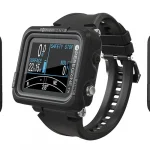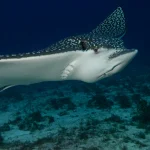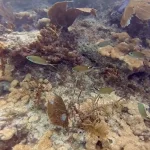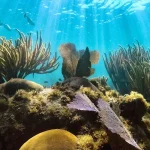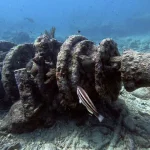Table of Contents
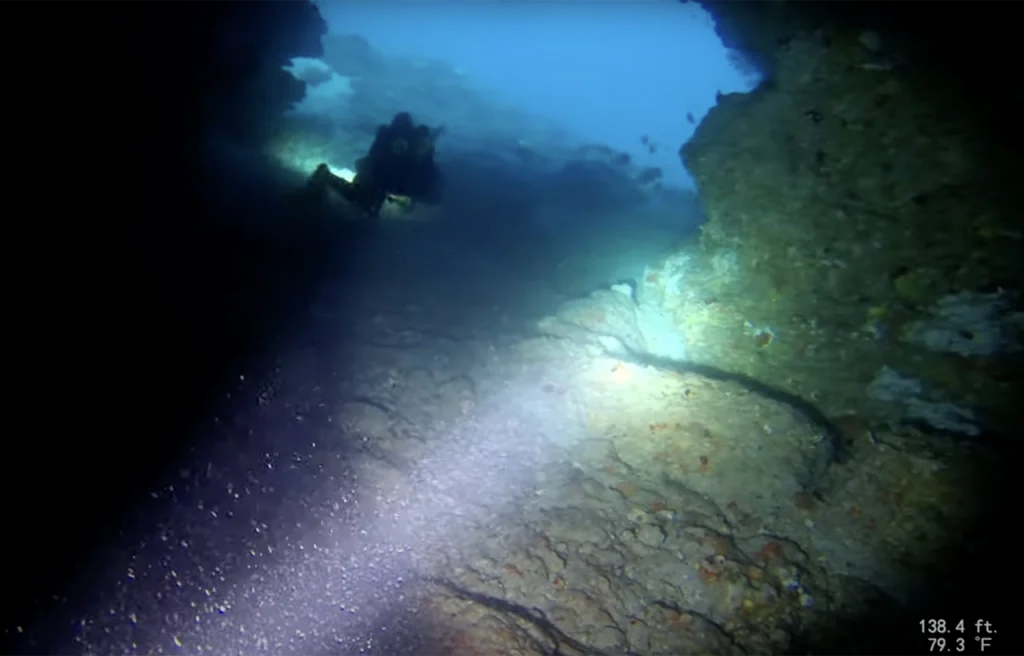
Divers can expect to encounter a diverse array of marine life, particularly suited for advanced divers due to the site’s depth and conditions.
Article at a Glance
- Location: Situated off Jupiter, Florida, the Hole-in-the-Wall is a renowned dive site known for its underwater cave and rich marine biodiversity.
- Depth: The dive site features depths ranging from 120 to 147 feet (36 to 45 meters), making it suitable only for advanced divers.
- Currents: Strong Gulf Stream currents (1–2 knots) are common, necessitating drift diving techniques and careful timing for descent.
- Visibility: Divers can typically expect visibility between 60 to 80 feet (18 to 24 meters), enhancing the underwater experience.
- Marine Life: The site is home to diverse marine species, including Goliath groupers, bull sharks, blacktip sharks, and various schools of fish.
- Best Diving Seasons: The optimal times to dive are August to September for Goliath grouper spawning and January to March for shark sightings.
- Technical Requirements: Divers must have advanced certifications (e.g., Advanced Nitrox or DSAT 40) and be experienced in handling decompression dives and strong currents.
The Hole in the Wall Palm Beach
The “Hole-in-the-Wall” dive site off Jupiter, Florida, is a renowned and challenging underwater location suitable only for advanced divers. It features a deep-water ledge with a cave that begins at 120 feet and extends to 147 feet in depth.
The cave has a 40-foot-wide by 10-foot-high opening, cutting back 35–40 feet before making a sharp right turn to an exit of similar dimensions. The site is known for its strong Gulf Stream currents, requiring precise timing and drift diving techniques for safe access.
This dive is famous for its marine life, including large cubera snappers, gray and goliath groupers, and various shark species like bull and blacktip sharks.
Historically, it was a popular spot for spearfishermen and adventurous divers in the 1970s, earning a reputation as a playground for the “Guerrilla Divers,” a group of risk-taking local hunters.
Today, the site is treated as a technical dive requiring advanced certifications such as nitrox or rebreather training due to its depth and decompression requirements. Dive operators from both Jupiter and West Palm Beach offer charters to the Hole-in-the-Wall, though trips may be canceled if currents are too strong.
What Marine Life Can I Expect To See?
Common Marine Species:
- Sharks: Large bull sharks are present year-round, along with blacktip, dusky, silky, and sandbar sharks. Tiger and greater hammerhead sharks have also been sighted occasionally.
- Goliath Groupers: This site serves as a spawning ground for Goliath groupers, with sightings peaking from August to October. These large fish can weigh between 120 and 350 pounds.
- Other Fish: Expect to see various species including cubera snappers, barracudas, and different types of grouper. The area is also home to unique species like angel sharks and rays.
Unique Features:
The site features a cavernous environment that begins at depths of around 140 feet and extends deeper. The cave itself has a large opening, making it an intriguing spot for divers to explore while observing the marine life that frequents these depths.
Visibility and Conditions:
Visibility typically ranges from 25 to 30 feet, but conditions can vary significantly due to strong currents, making it essential for divers to have advanced skills and experience.
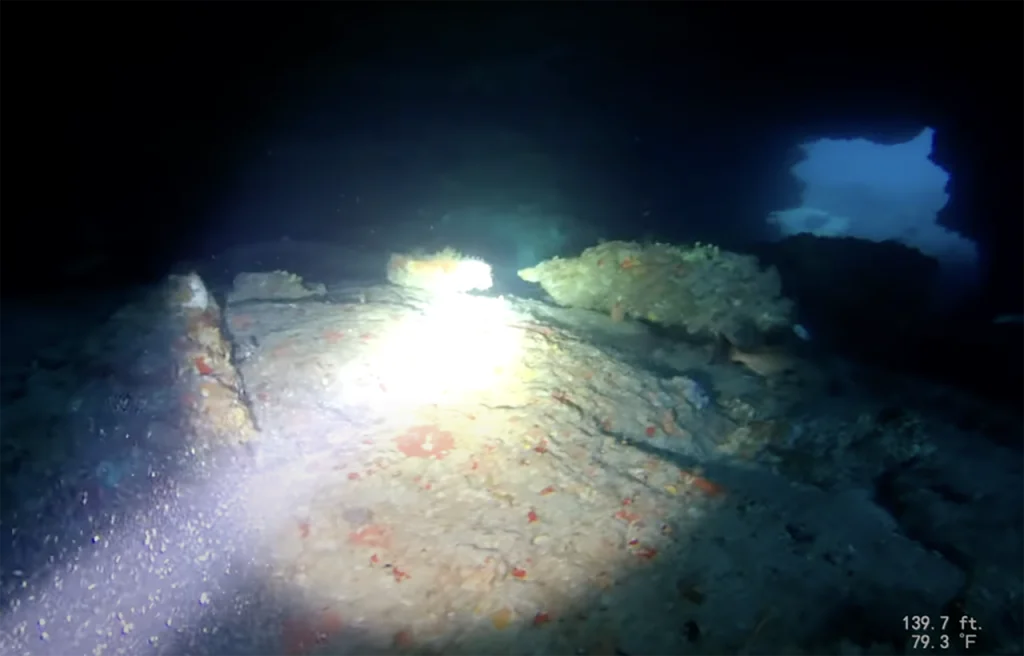
What Do Divers Say About This Site?
- Advanced Diving Experience: Many divers emphasize that the Hole-in-the-Wall is strictly for advanced divers due to its depth (ranging from 120 to 147 feet) and strong currents, which can reach 1 to 2 knots. The site requires drift diving techniques, where divers are dropped upstream and must time their descent carefully to reach the cave entrance.
- Marine Life Encounters: Divers frequently mention the thrill of encountering large marine life, including bull sharks, blacktip sharks, and Goliath groupers. The site is known for attracting these “big players” of the reef, which adds to its allure. Some divers recount exciting experiences with sharks resting inside the cave or swimming nearby, enhancing the dive’s adrenaline factor.
- Technical Challenges: The dive is described as requiring significant energy and skill, particularly at depth. Divers have noted that navigating the currents and managing buoyancy can be physically demanding, making it a true test of their diving abilities.
- Historical Context: The site has a storied past, having been frequented by local spearfishermen known as the “Guerrilla Divers” in the 1970s. These divers were known for their adventurous spirit and often returned with impressive catches from this area.
- Overall Sentiment: While the dive is not for novices, those who have experienced it often regard it as a must-do for advanced divers looking for an exhilarating underwater adventure. The combination of technical challenges, stunning marine life, and a sense of exploration makes it a memorable dive site.
Key Information
| Key Information | Details |
|---|---|
| Location | Hole-in-the-Wall, off Jupiter, Florida |
| Depth Range | 120 to 147 feet (36 to 45 meters) |
| Suitability | Advanced divers only |
| Certification Requirements | Advanced Nitrox or DSAT 40 |
| Current Conditions | Strong Gulf Stream currents (1–2 knots) |
| Visibility | Typically 60 to 80 feet (18 to 24 meters) |
| Marine Life | Goliath groupers, bull sharks, blacktip sharks, cubera snappers, and various pelagic fish |
| Best Time to Dive | August–September (Goliath grouper spawning season); January–March (shark season) |
| Technical Challenges | Drift diving, decompression stops required |
| Recommended Gear | Wide-angle lens, strobes, dive computer, lift bags |
Highlights of Diving This Site?
- Depth and Structure: The dive site features a cave within a deep-water ledge, with depths ranging from approximately 120 feet to 147 feet. The cave has a large entrance measuring about 40 feet wide and 10 feet high, leading into a tunnel that extends back 35 to 40 feet before making a sharp right turn to exit.
- Strong Currents: Divers often face strong Gulf Stream currents, which can reach speeds of 1 to 2 knots. This necessitates drift diving techniques, where divers are dropped upstream and must time their descent carefully to reach the cave entrance effectively.
- Marine Life: The site is renowned for its diverse marine life. Divers can expect encounters with large species such as bull sharks, blacktip sharks, and Goliath groupers, especially during their spawning season from August to October. Other notable species include cubera snappers and various pelagic fish.
- Challenging Conditions: Due to its depth and current conditions, the Hole-in-the-Wall is recommended only for experienced divers. Many divers appreciate the technical challenge it presents, making successful dives here particularly rewarding.
- Historical Significance: The site has a rich history dating back to the 1970s when it was frequented by spearfishermen who returned with impressive catches. The return of Goliath groupers after years of protection has added to its allure for divers today.
- Unique Experience: The combination of thrilling underwater topography, strong currents, and the chance to see large marine life makes the Hole-in-the-Wall a must-visit for advanced divers looking for an unforgettable adventure.
My Favorite Dive Computers
I have compared the 3 top diving computers for each category to help making the right choice easier:
Iconic Spots At This Site
- The Cave Entrance: The most notable feature is the large cave opening, measuring 40 feet wide and 10 feet high, located on the eastern face of a deep-water ledge. This entrance leads into a passage that extends 35–40 feet before making a sharp right turn to an equally large exit.
- Deep-Water Ledge: The site is situated along a ledge that runs north to south, with depths ranging from 120 feet at the top of the ledge to 147 feet at its deepest point. This ledge provides an exciting terrain for exploration.
- Marine Life Hotspot: The cave and surrounding areas are teeming with marine life, including bull sharks, blacktip sharks, and Goliath groupers, particularly during their spawning season. The ledge also attracts schools of snappers, barracudas, and other pelagic fish.
- Challenging Currents: The strong Gulf Stream currents add an extra layer of excitement and technical challenge, making it a favorite among experienced divers who enjoy drift diving.
Environmental Conservation Efforts at Hole-in-the-Wall
- Federal Protection for Goliath Groupers: The Goliath grouper was placed under federal protection in 1990, leading to a remarkable comeback. By August 2002, these fish returned to the Hole-in-the-Wall as a spawning aggregation site after nearly 30 years of absence. This resurgence is seen as a significant success for conservation efforts aimed at restoring this species’ population.
- Research and Monitoring: Researchers from Florida State University have been actively involved in monitoring the Goliath grouper population. They tagged and tracked these fish to study their behavior and movements, contributing valuable data to conservation science. In one notable aggregation event, researchers identified 42 large groupers and tagged 24 adults weighing between 120 and 350 pounds (2).
- Shark Conservation: The Hole-in-the-Wall site has also seen a healthy comeback of various shark species, including bull sharks, blacktip sharks, and even greater hammerhead sharks. Conservation efforts focus on educating divers about the importance of these apex predators in maintaining marine ecosystems (1).
- Community Engagement: Local dive operators often promote responsible diving practices and conservation awareness among divers. Initiatives such as PADI AWARE programs encourage divers to participate in conservation activities, including shark conservation classes that educate participants on protecting marine life.
- Habitat Restoration Efforts: While specific restoration projects at Hole-in-the-Wall are not detailed in the search results, broader habitat restoration initiatives in nearby areas, such as Blowing Rocks Preserve, highlight ongoing efforts to protect coastal ecosystems in Florida. These initiatives often include removing invasive species and replanting native flora, which can positively impact marine habitats indirectly (3).
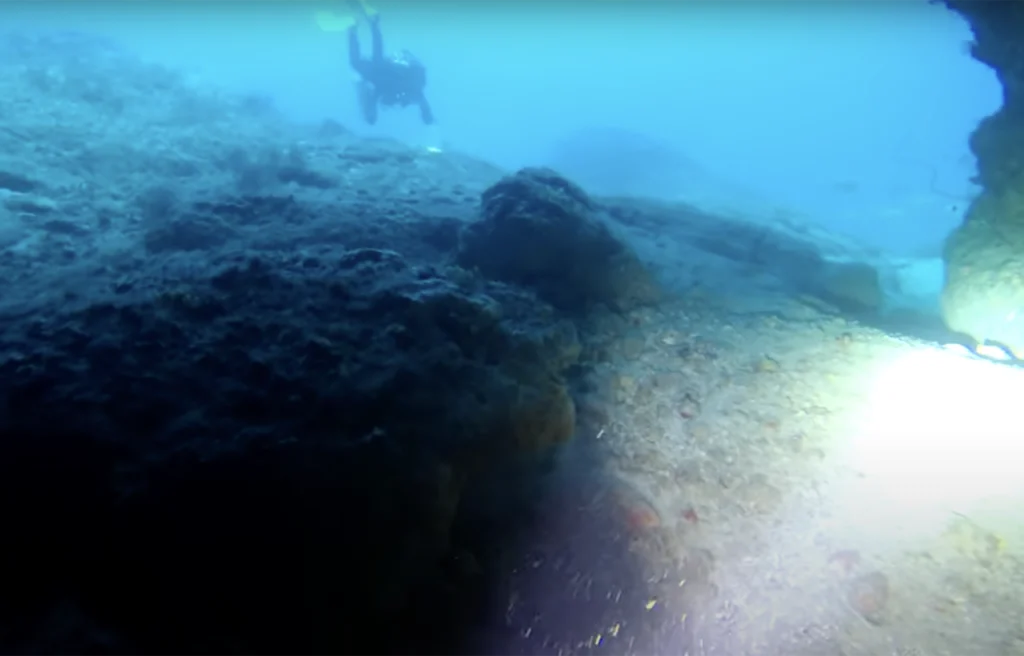
Maximizing Your Diving Experience at Hole-in-the-Wall
Understand the Dive Conditions
- Depth Awareness: The site ranges from 120 to 147 feet deep, making it suitable only for advanced divers. Ensure you have the appropriate certifications, such as Advanced Nitrox or DSAT 40.
- Current Management: The Gulf Stream often creates strong currents (1 to 2 knots). Be prepared for drift diving, where you’ll be dropped up to 150 yards upstream of the site. Timing your descent is crucial to reach the cave entrance effectively.
Plan Your Dive
- Choose the Right Operator: Select a dive operator familiar with the Hole-in-the-Wall. They will provide guidance on current conditions and safety measures.
- Know Alternative Sites: Be aware that if conditions are unfavorable, dive charters may switch to other sites like the Jupiter Wreck Trek or Princess Ann wreck. Familiarize yourself with these alternatives.
Gear Up Properly
- Technical Equipment: Bring necessary gear for technical diving, including a personal lift bag and appropriate tanks for decompression dives.
- Safety Equipment: Ensure you have a dive computer capable of handling decompression profiles and a reliable way to communicate with your dive buddy.
Dive Techniques
- Slow Down: Many divers rush through drift dives but moving slowly allows you to observe marine life better. Patience is key; take time to appreciate the vibrant ecosystem.
- Buddy System: Always dive with a buddy and maintain communication throughout the dive. This is especially important given the site’s depth and current.
Enjoy Marine Life
- Look for Iconic Species: Be on the lookout for Goliath groupers, bull sharks, and various tropical fish species that frequent the area. The ledge often hosts schools of jacks and bonito.
- Respect Wildlife: Observe marine life from a distance and avoid touching or disturbing their habitat.
Post-Dive Reflection
- Discuss Experiences: After your dive, share experiences with fellow divers. This can provide insights into what you might have missed and enhance future dives.
Capturing Memories at Hole-in-the-Wall: Photography Tips
Gear and Equipment
- Wide-Angle Lenses: Use a fisheye or rectilinear wide-angle lens to capture large marine life like sharks and Goliath groupers. A fisheye zoom is ideal for close encounters.
- Strobes: Position strobes high and wide to reduce backscatter, especially in sandy environments (5).
- Camera Tray: A camera tray can improve stability and help you handle your gear comfortably in strong currents.
Master Your Diving Skills
- Neutral Buoyancy: Perfect your buoyancy control to avoid disturbing the environment or stirring up sediment, which can ruin shots.
- Streamlined Gear: Keep your dive gear streamlined to move efficiently through strong currents and avoid missing fast-moving subjects.
Composition Techniques
- Shoot Upwards: Always aim to shoot upwards or level with your subject to utilize natural light and create more dynamic images. Avoid shooting downwards, as this often results in dark or flat images (4).
- Rule of Thirds: Place your subject off-center using the rule of thirds for visually appealing compositions.
- Focus on Eyes: Ensure the subject’s eyes are sharp and in focus for compelling photos.
Lighting and Color
- Get Close: Stay within 12 inches of your subject to reduce water distortion and enhance color and detail. Use strobes for vibrant colors when shooting at depth.
- Manual White Balance: Adjust white balance manually at different depths for accurate color representation.
Behavioral Awareness
- Stay Calm: Marine life like sharks are naturally curious but will only approach if you remain calm and avoid sudden movements. Let them come to you for close-up shots.
- Be Patient: Wait for the perfect moment to capture marine life in action or interesting poses. This is especially important when photographing large predators or schools of fish.
Plan Ahead
- Previsualize Shots: Anticipate what you might see during the dive and adjust your camera settings (e.g., aperture, ISO, strobe position) before encountering subjects.
- Check Behind You: Look around frequently, as some of the best compositions may appear behind you during a drift dive.
Post-Dive Review
- Review your images after the dive to identify areas for improvement. Check sharpness by zooming in at 100% magnification and analyze exposure using a histogram.
Frequently Asked Questions
When is the best time to dive Hole-in-the-Wall
The best time to dive the Hole-in-the-Wall site off Jupiter, Florida, depends on the marine life you want to see and the seasonal conditions:
Goliath Grouper Season (August–September)
This is the most popular time to dive as Goliath groupers aggregate to spawn. Divers can witness dozens of these massive fish, creating a spectacular underwater experience.
Shark Season (January–March)
During this period, lemon sharks and migrating blacktip sharks are commonly seen in the area. This is an excellent time for divers interested in large pelagic species.
General Conditions
The Gulf Stream ensures warm water temperatures year-round, making diving possible in all seasons.
Currents at the site are strong year-round, so conditions must be assessed daily. Dive charters may cancel trips if currents are too intense.
For the best experience, plan your dive during Goliath grouper season or shark season while coordinating with local dive operators to ensure favorable conditions.
What is the visibility like while diving Hole-in-the-Wall
Visibility while diving at the Hole-in-the-Wall site off Jupiter, Florida, typically ranges from 60 to 80 feet. However, this can vary based on conditions such as currents and weather. On good days, divers often report excellent visibility, enhancing the experience of exploring the underwater cave and observing marine life like Goliath groupers and various shark species.
It’s important to note that visibility can be affected by strong currents, which are common at this site. The Gulf Stream can create challenging conditions, sometimes necessitating dive operators to adjust plans based on real-time assessments of visibility and current strength. Therefore, checking with local dive operators for the latest visibility reports before your dive is advisable.
How deep are the dives at Hole-in-the-Wall
The dives at the Hole-in-the-Wall site off Jupiter, Florida, typically range from 120 feet (approximately 36 meters) to 147 feet (approximately 45 meters) deep. The cave itself features a significant opening that leads into a tunnel, making it a challenging dive primarily suited for advanced divers due to its depth and strong currents associated with the Gulf Stream.
Is Hole-in-the-Wall site off Jupiter suitable for beginners?
The Hole-in-the-Wall dive site off Jupiter, Florida, is not suitable for beginners. It is a highly technical dive requiring advanced skills and certifications due to the following factors:
Depth: The site ranges from 120 to 147 feet, exceeding the depth limits for recreational divers and requiring advanced nitrox or technical certifications.
Strong Currents: The Gulf Stream often creates north-flowing currents of 1 to 2 knots, making drift diving necessary. Divers must time their descent precisely to reach the cave entrance, adding complexity to the dive.
Decompression Profiles: Dives at this site typically involve decompression stops, requiring divers to have experience with deco procedures and proper equipment.
No Guided Dives: Technical charters are not guided, so divers must be self-sufficient and capable of handling emergencies independently.
This site is strictly for advanced or technical divers with certifications such as Advanced Nitrox, DSAT 40, or rebreather qualifications. Beginners are encouraged to explore other nearby sites better suited to their skill level.
Is Hole-in-the-Wall dive site off Jupiter suitable for advanced divers?
Yes, the Hole-in-the-Wall dive site off Jupiter, Florida, is highly suitable for advanced divers due to its depth, strong currents, and technical requirements.
Depth: The site ranges from 120 feet (36 meters) to 147 feet (45 meters), exceeding recreational limits and requiring advanced certifications such as Advanced Nitrox or DSAT 40.
Currents: The Gulf Stream creates strong north-flowing currents (1–2 knots), making drift diving necessary. Divers must time their descent carefully to reach the cave entrance.
Technical Profile: The dive often involves decompression stops, requiring experience with deco procedures and proper equipment like lift bags and dive computers.
Marine Life: Advanced divers are rewarded with sightings of bull sharks, blacktip sharks, Goliath groupers, and vibrant schools of fish.
This dive is strictly for those with advanced skills and certifications, as it combines technical challenges with a thrilling underwater environment.
Palm Beach Diving Sites
- Blue Heron Bridge
- Breakers Reef
- Flower Gardens
- Juno Ledge
- King Neptune
- Northwest Double Ledges
- South Double Ledges
- Cable Crossing
- Breakers 3rd Window
- Rons Rock
- Ballentine Reef
- Worth Avenue Pier Debris
- Playpen or Playground
- Bath and Tennis
- North and South Turtle Mounds
- Shark Canyon
- Larsens Valley
- Hole in the Wall

